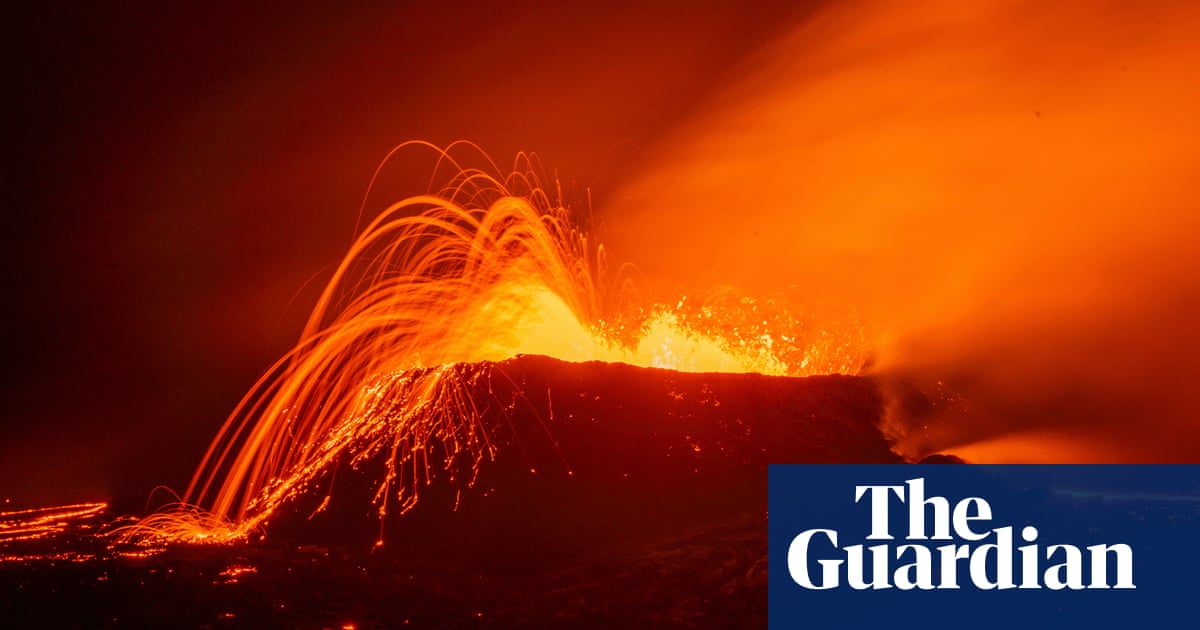It was about 7pm when UMF Grindavík’s players finished training in the club’s indoor hall. There had been seismic activity in the area all day but, in this harbour town to the south of Iceland’s famous Blue Lagoon, everybody had become wearily used to that. Earthquakes and volcanic eruptions had been a discomfiting, menacing backdrop to the previous three years. Everyday life had continued but now, on 10 November 2023, nature was to have its say. Four hours after its football team had completed their session, the danger had become intolerable and Grindavík was evacuated. Their once-thriving home quickly turned into a ghost town.
Nobody would dream of using the hall for football now. Its pitch is cleaved in two by a fissure up to 25 metres deep; one of the most striking images in a settlement that has been ripped apart. A chasm has destroyed their outdoor practice pitch too. But something remarkable will happen in Grindavík on Saturday: football will lead the way in a recovery few could have foreseen over the past 18 months. Grindavík will play at their Stakkavíkurvöllur home for the first time since the town’s abandonment, hosting Fjölnir in a second-tier fixture whose outcome feels distinctly secondary.
Haukur Guðberg Einarsson never lost faith that Grindavík would return, not even when eight more eruptions ravaged the surrounding area and hampered any attempts to rebuild. “That’s been my mission every day and every night,” says the club chair, whose lifelong involvement there began as a player. “I’ve been fighting with nature but never gave up: never, ever.”
Residents were allowed to visit Grindavík in the weeks after evacuation, restricted to a few minutes in which they could gather belongings. “I had to focus on my family first,” Einarsson says. “Then I turned to the football club. For about three weeks I travelled back and forth in bad winter conditions. I had to save the club and put it somewhere.”
Grindavík were initially housed by Víkingur Reykjavík. “They kept us alive,” Einarsson says. “We were just freefalling and they grabbed us.” A number of other local clubs assisted too, although games were sparsely attended. “People were mentally not good,” he continues. The town’s economy had been decimated: the club lost 40% of its sponsors and Einarsson was among hundreds to lose their jobs as companies shut down. It did, at least, mean he could devote more time to his obsession. Grindavík needed to be home, at the picturesque Stakkavíkurvöllur, whose main surface had miraculously avoided destruction, as soon as it was deemed safe.
“I had to talk with the government, lots of meetings with the police, lots of experts who had to check whether everything was OK under the pitch,” he says. “We don’t want to take people if it’s not 150% safe. Many times we had to take one step forward and two steps back: you’d try to work and then we’d be told another eruption was coming and have to leave again. We were working, testing and waiting for what nature was going to do next.”
When the latest eruption, as recently as 1 April, sent lava spewing towards the town, Einarsson feared his quest was destined to fail. “I thought it was the last time I would ever see the pitch,” he says. But it stopped short and, on Monday, Stakkavíkurvöllur was given the all-clear. Geophysical surveys showed the renovated venue was not at risk and up to 1,500 supporters could attend on Saturday. There will be a concert, children’s entertainment, food stands and the sense of a community reuniting around one of its most precious institutions.
“This is a huge, huge thing for us in Grindavík,” Einarsson says. “It was very special to be told we can play. It’s very hard for me to explain my feelings about this. Everything I own, all of my life, is Grindavík.”
It does not mean Grindavík will return immediately to its old self. While the town has been back open since late October, only about 40 houses are occupied. Many dwellings are ruined beyond repair. The football club are an advance party of hope, of promise that better times will eventually arrive. “There are people that can’t go back, or won’t because they are scared or heartbroken,” he says. “It’s going to take many years to build Grindavík up again.”
Sign up toFootball Daily
Kick off your evenings with the Guardian's take on the world of football
after newsletter promotion
The squad have been training at Stakkavíkurvöllur over the past month; recently they have conspicuously taken post-session meals at a nearby pizza restaurant that has reopened. They wanted to be seen out and about, presenting a vision of normality away from the field. But there are reminders of the surreal, terrifying context in every glance: the club’s biggest sponsor, whose name is emblazoned on their shirts, has built the 12-metre high defence walls that now circle the town to prevent it being overwhelmed by lava flow.
Grindavík, who count the former Manchester United and England winger Lee Sharpe among their alumni, have a proud history and will seek a return to the Úrvalsdeild, Iceland’s top flight, one day. A young side, largely rebuilt with academy players, they are unlikely to achieve that this season but are about to accomplish something far bigger. The people of Grindavík may still have to reckon with a traumatic past, but they can see a beacon to the future.
“We start step by step,” Einarsson says. “It will be OK. With a big heart and all the will in the world, it’s possible that Grindavík will be alive again.”
